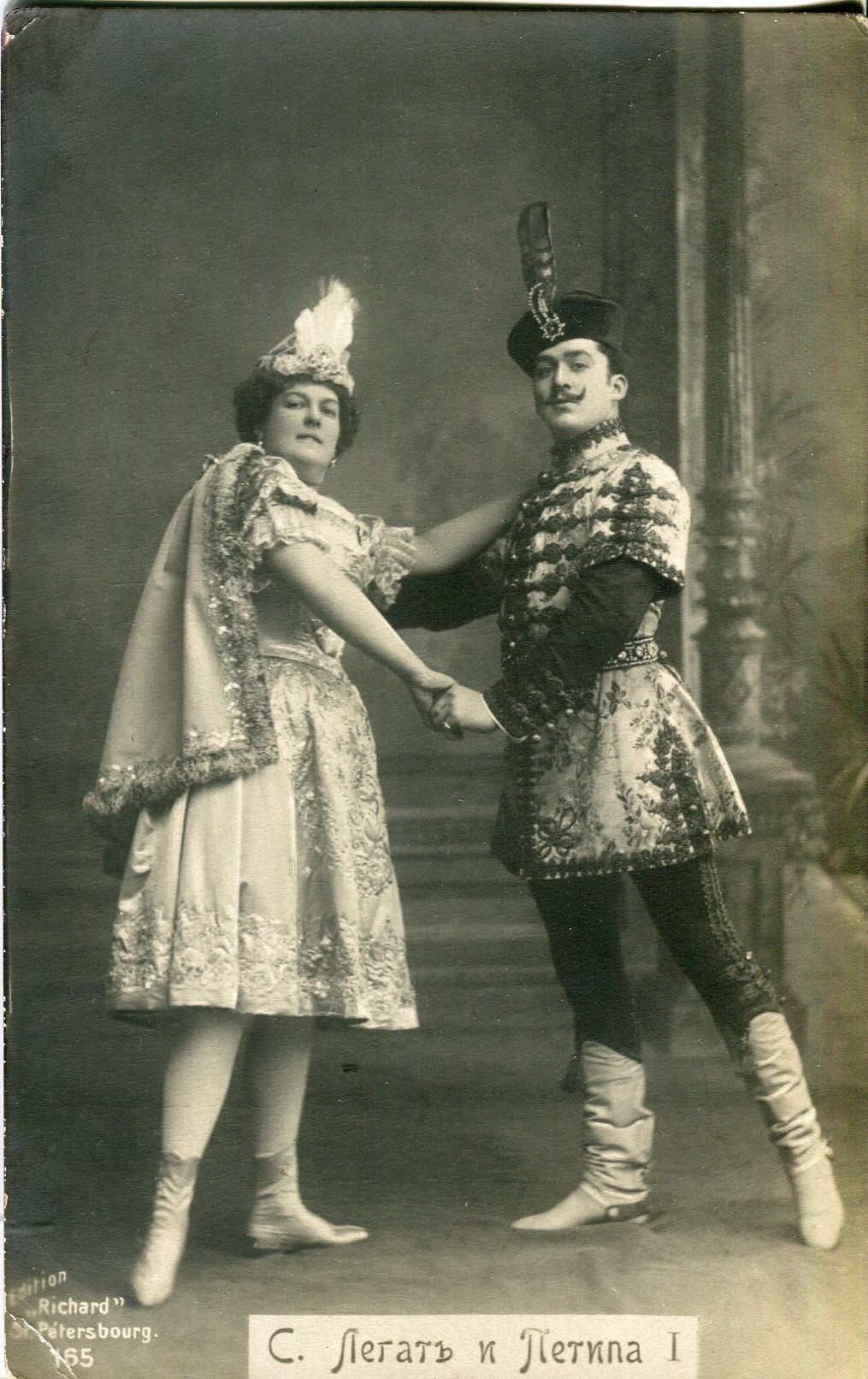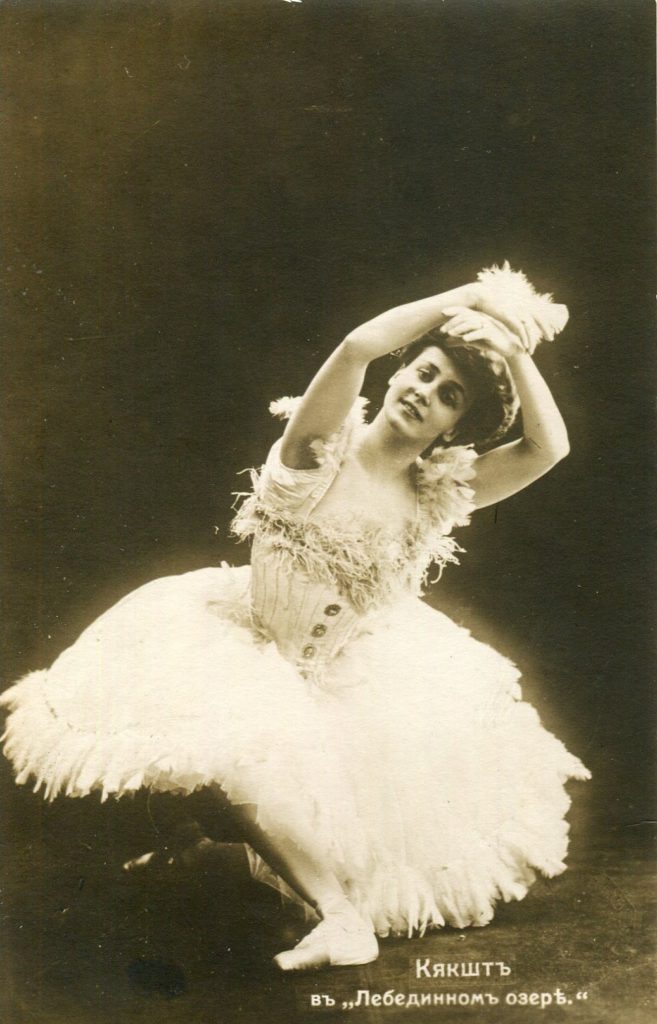Our Ballet: Photo cards from the Russian imperial era, part two - Vancouver Ballet Society
- Home
- Features 2020 - 2023
- Our Ballet: Photo cards from the Russian imperial era, part two

By Robert Greskovic
Featuring three more photo cards from Robert Greskovic’s personal collection. Part one is available here.
The card below shows Marie Petipa and Sergei Legat in the Pas Hongrois czardas from the Act 2 ballroom scene of Swan Lake by Marius Petipa and Lev Ivanov. The photo must have been taken after the production’s 1895 premiere, as at that time Alfred Bekefy danced the czardas (part of a divertissement that included eight couples framing the leading one) with Marie. The pose featured in the card indicates something of the shape and accent of a moment from the choreography. The cant of the two dancers’ downstage shoulders provides a touch of the characteristic Slavic accentuations that Petipa set for his choreography.

“Edition Richard, St. Petersbourg,” the credit found in the lower left corner of the card, refers to the Richard publishing house which had exclusive rights for such pictures of imperial theatre dancers until 1905, when Fischer, a Moscow and St. Petersburg photographic studio, got the rights. The prominent caption beneath the dancers spells out their names in Russian.
The costuming is by Evgeny Ponomaryov; the headwear and footwear are from individual makers. The decorative painted background behind the dancers was one of six or so such designs used by Richard during its photo sessions of imperial dancers; these were generic decorative backdrops to frame the dancers.
Historically, Marie Petipa (1857-1930), Marius’ eldest daughter, was maligned as owing her rich stage career more to her father’s auspices than to her talent. Sergei Legat (1875-1905) was the younger brother of Nikolai Legat, who had a substantial career outside Russia after the Russian Revolution; he died in 1937. The junior Sergei was also considered a major talent, until his untimely death, a suicide, in 1905.
*

This photo card of Lydia Kyaksht, named in the caption simply as Kyaksht, incorrectly identifies the role and costume shown. The card notes the ballet in question as Swan Lake (Lebednoi ozero, in Roman spelling of the Russian Cyrillic). Actually, she’s wearing the costume for Princess Florine in the Blue Bird pas de deux, designed by Ivan Vsevolozhsky for the 1890 premiere of Marius Petipa’s The Sleeping Beauty.
According to my research, Kyaksht seems not to have danced any roles in Swan Lake. This inaccurate caption is a good example of why it is important to always double-check facts with more than one source. Kyaksht is documented as having danced Princess Florine in 1914, and there are visual sources that document this costume as Florine’s. Also, Kyaksht seems to be striking the choreographic pose Florine takes at the end of the pas de deux, before its variations and coda.
Biographical information for Kyaksht (1885-1959) states that her career after the 1917 Revolution took place in the West, mainly from London, where she relocated.
Note: Lydia Kyaksht was known as Lydia Kyasht in the west, probably because it was easier for non-Russians to twist their tongues around her surname without the second “k.” A simplification was also common for Olga Spesivtseva’s surname, often shortened to Spessiva.
*
Pyotr (Pierre) Vladimirov is presented here in a studio portrait as the title figure in Eros, Michel Fokine’s 1915 one-act ballet set to Tchaikovsky’s Serenade for Strings (the same music Balanchine used for his 1935 Serenade). Vladimirov posed in the plain setting of the studio of Dmitri Bystrov, the photographer who took over the officially sanctioned photo card production for the imperial theatres in 1914. His predecessor, Karl Fischer, had to give up the work as a persona-non-grata German at the advent of the First World War.

Eros, Fokine’s narrative ballet, was based on a story by Valerian Svetlov, a prominent dance critic and writer. It concerns a young woman to whom the statue of Eros appears, in person, after he comes down off his pedestal. It’s likely the statuesque pose Vladimirov chose to strike here is one that Eros held on his pedestal before leaving it to beguile the ballet’s Young Woman, played at the premiere by Mathilde Kshesinskaya. Settings for the two scenes were by Mikhail Bobyshov, who also designed the costumes, including that worn by Vladimirov in this photo.
Vladimirov (1893-1970) fled Russia in 1920 to conduct his career in the West, in New York, where he was on the faculty of the School of American Ballet.
STAY TUNED FOR PART THREE OF ROBERT GRESKOVIC’S SERIES OF PHOTO CARDS, FEATURING SOVIET DANCERS, COMING IN JUNE.

